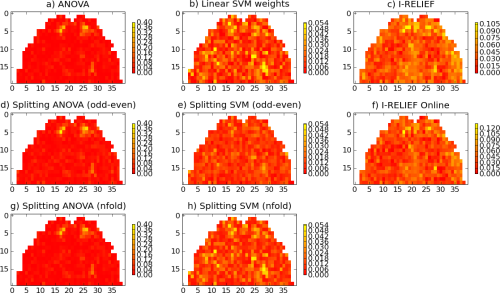 |
Multivariate Pattern Analysis in Python |
 |
Multivariate Pattern Analysis in Python |
Run some basic and meta sensitivity measures on the example fMRI dataset that comes with PyMVPA and plot the computed featurewise measures for each. The generated figure shows sensitivity maps computed by six sensitivity analyzers.
We start by loading PyMVPA and the example fMRI dataset.
from mvpa.suite import *
# load PyMVPA example dataset
attr = SampleAttributes(os.path.join(pymvpa_dataroot, 'attributes.txt'))
dataset = NiftiDataset(samples=os.path.join(pymvpa_dataroot, 'bold.nii.gz'),
labels=attr.labels,
chunks=attr.chunks,
mask=os.path.join(pymvpa_dataroot, 'mask.nii.gz'))
As with classifiers it is easy to define a bunch of sensitivity analyzers. It is usually possible to simply call getSensitivityAnalyzer() on any classifier to get an instance of an appropriate sensitivity analyzer that uses this particular classifier to compute and extract sensitivity scores.
# define sensitivity analyzer
sensanas = {
'a) ANOVA': OneWayAnova(transformer=N.abs),
'b) Linear SVM weights': LinearNuSVMC().getSensitivityAnalyzer(
transformer=N.abs),
'c) I-RELIEF': IterativeRelief(transformer=N.abs),
'd) Splitting ANOVA (odd-even)':
SplitFeaturewiseMeasure(OneWayAnova(transformer=N.abs),
OddEvenSplitter()),
'e) Splitting SVM (odd-even)':
SplitFeaturewiseMeasure(
LinearNuSVMC().getSensitivityAnalyzer(transformer=N.abs),
OddEvenSplitter()),
'f) I-RELIEF Online':
IterativeReliefOnline(transformer=N.abs),
'g) Splitting ANOVA (nfold)':
SplitFeaturewiseMeasure(OneWayAnova(transformer=N.abs),
NFoldSplitter()),
'h) Splitting SVM (nfold)':
SplitFeaturewiseMeasure(
LinearNuSVMC().getSensitivityAnalyzer(transformer=N.abs),
NFoldSplitter()),
}
Now, we are performing some a more or less standard preprocessing steps: detrending, selecting a subset of the experimental conditions, normalization of each feature to a standard mean and variance.
# do chunkswise linear detrending on dataset
detrend(dataset, perchunk=True, model='linear')
# only use 'rest', 'shoe' and 'bottle' samples from dataset
dataset = dataset.selectSamples(
N.array([ l in [0,3,7] for l in dataset.labels],
dtype='bool'))
# zscore dataset relative to baseline ('rest') mean
zscore(dataset, perchunk=True, baselinelabels=[0], targetdtype='float32')
# remove baseline samples from dataset for final analysis
dataset = dataset.selectSamples(N.array([l != 0 for l in dataset.labels],
dtype='bool'))
Finally, we will loop over all defined analyzers and let them compute the sensitivity scores. The resulting vectors are then mapped back into the dataspace of the original fMRI samples, which are then plotted.
fig = 0
P.figure(figsize=(14, 8))
keys = sensanas.keys()
keys.sort()
for s in keys:
# tell which one we are doing
print "Running %s ..." % (s)
# compute sensitivies
# I-RELIEF assigns zeros, which corrupts voxel masking for pylab's
# imshow, so adding some epsilon :)
smap = sensanas[s](dataset)+0.00001
# map sensitivity map into original dataspace
orig_smap = dataset.mapReverse(smap)
masked_orig_smap = N.ma.masked_array(orig_smap, mask=orig_smap == 0)
# make a new subplot for each classifier
fig += 1
P.subplot(3, 3, fig)
P.title(s)
P.imshow(masked_orig_smap[0],
interpolation='nearest',
aspect=1.25,
cmap=P.cm.autumn)
# uniform scaling per base sensitivity analyzer
if s.count('ANOVA'):
P.clim(0, 30)
elif s.count('SVM'):
P.clim(0, 0.055)
else:
pass
P.colorbar(shrink=0.6)
if cfg.getboolean('examples', 'interactive', True):
# show all the cool figures
P.show()
Output of the example analysis:

See also
The full source code of this example is included in the PyMVPA source distribution (doc/examples/sensanas.py).